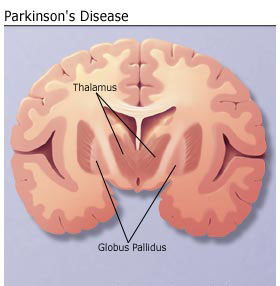PALLIDOTOMY SURGERY IN INDIA

Patients with advanced hemiparkinson’s disease(symptoms either unilateral or more on one side) are good candidate for Pallidotomy. Pallidotomy is usually successfull in reducing some but not all symptoms in parkinsopns disease. In Pallidotomy technique a small Thermocoagulation (circuit break) is done at postero-ventral part of Pallidum. Pallidotomy helps the patient on the controlateral side of surgery. It improves tremor, stiffness and drug induced side effects called as dyskinesia.
Diagnosis/Preparation Surgery in india
 Pallidotomy is performed in patients with Parkinson’s disease who are still responsive to levodopa, but who have developed disabling drug treatment complications known as motor fluctuations, including rapid wearing off of drug effect, unpredictable “off states” (times of low levodopa levels in the blood), and disabling dyskinesias. Those who are very elderly, demented, or with other significant medical conditions that would be compromised by surgery are usually not candidates for pallidotomy.
Pallidotomy is performed in patients with Parkinson’s disease who are still responsive to levodopa, but who have developed disabling drug treatment complications known as motor fluctuations, including rapid wearing off of drug effect, unpredictable “off states” (times of low levodopa levels in the blood), and disabling dyskinesias. Those who are very elderly, demented, or with other significant medical conditions that would be compromised by surgery are usually not candidates for pallidotomy.
he surgical candidate should discuss all the surgical options with the neurologist before deciding on pallidotomy. A full understanding of the risks and potential benefits must be understood before consenting to the surgery.
The patient will undergo a variety of medical tests, and one or more types of neuroimaging procedures, including magnetic resonance imaging (MRI), computed tomagraphy (CT) scanning, angiography (imaging the brain’s blood vessels), and ventriculography (imaging the brain’s ventricles). On the day of the surgery, the stereotactic frame will be fixed to the patient’s head. First, a local anesthetic is applied at the four sites where the frame’s pins contact the head; there may nonetheless be some initial discomfort. A final MRI is done with the frame in place to help set the coordinates of the GPi in relation to the frame.
Risks
The key to successful outcome in pallidotomy is extremely precise placement of the electrode. While there are several controversies in the field of PD surgery, all experts agree that risks are reduced in procedures performed by the most experienced neurosurgeons.
Hemorrhage in the brain is a possible complication, as is infection. There are small but significant risks of damage to the optic tract, which can cause visual deficits. Speech impairments may also occur, including difficulty retrieving words and slurred speech. Some cognitively fragile patients may become even more impaired after surgery.







